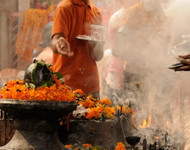Sacred Smoke & Symbolism of Smoke in different Traditions
Posted by Jenny Smedley
Since the dawn of time we’ve been fascinated by smoke. It seems to symbolise our constant striving to reach the heavens, or the beings that might dwell there. Since man first turned his eyes skywards, smoke has been used as a conduit for prayers, seen as the souls of the dead rising into heaven, for energy shifting and even communication.
Vikings
The earliest use of smoke in lifting us was in the cremation of dead bodies. The most evocative image must be that of a Viking funeral, where the departed would be placed on a ship or raft and pushed out into the fiord. This started his journey to the afterlife, but then flaming arrows would be fired at it until the entire ship was ablaze and the spirit of the dead Viking carried into up into Valhalla by the smoke as it ascended into the night sky. But even before this, primitive cultures burned their dead, seeing in the rising smoke the material manifestation of the soul’s journey.
The scent of perfumed smoke from incense can be found in one form or another in almost every place of worship on the planet. In temples, churches, monasteries and pagan ritual sites, it matters not which particular form of religion is followed, smoke permeates it.
Aboriginals & Native Americans
Smoke was used extensively in Aboriginal rituals. A woman giving birth would crouch over a fire and then hold her baby in the smoke from the fire to seal his spirit into his mortal body. At each big step in the child’s life he would be purified and sealed by the smoke again. This was particularly evident at the coming of age. Males were circumcised and then they stood in the smoke to help heal the wound. The boys also believed that if they placed soaked lily leaves or damp grass on some heated stones, the steam rising from it would not only purify them, as it passed through their bodies from anus to mouth, but would also make them grow into strong men.
Native Americans used smoke for many things. The Navajo interestingly, shared a belief with Pygmies. The houses of dead people were burned, as were the actual bodies. The mourners would then stand in smoke from a sacred fire to cleanse themselves of the energy of death.
They also used smoke in communication - smoke signals, where damp leaves being burned on a high place would create clouds of dense smoke, which could be seen for miles. A blanket dropped in sequence over the fire, and causing gaps in the up-pouring smoke would deliver a message to a far off friend. There was not a standardized code as such, because the transmission was of secret information, and the number of ‘puffs’ would be devised in advance by the transmitter and the person receiving.
A third Native American use would be ‘smudging’. Smudging is done to drive away sickness and bad energy and to help centre the people taking part in the ceremony. Traditionally a bowl is filled with tobacco (ah-say-ma), sweet grass, sage, and cedar. The smudge pot is fanned with a feather all around the room so that the smoke reaches every corner and then every person in the room. Each person bathes in the smoke, starting with the heart area first, next the head area, and then the arms, then downward toward the legs.
In Trinidad the Caribs burn incense. Corn is placed on a fire and a feather is wafted over the fire to make sure the smoke covers the male participants. Cigar and tobacco smoke is also puffed over the men by the Shaman. This is to cleanse and strengthen them. Any smoke entering a bodily orifice would take in with it the power of the spirit carried in the smoke.
Christians and the Catholic Church
In Christian religions the smoke from the incense, with its sweet-smelling perfumes is seen as the symbol of the prayers, rising up to God in his heaven. The Bible is full of references.
Rev. 8:3-4 Another angel with a golden censer came and stood at the altar; he was given a great quantity of incense to offer with the prayers of all the saints on the golden altar that is before the throne. And the smoke of the incense, with the prayers of the saints, rose before God from the hand of the angel.
The Catholic Church has developed a very significant use of smoke over the centuries. As well as burning incense to make it in the ceremonies, they also use it for smoke signals! During the election of a new pope the eligible cardinals conduct secret ballots until one person receives the critical vote of two-thirds plus one. Each time a vote is complete, the ballots are burned. To signify an unsuccessful ballot, straw is mixed with the papers to produce black smoke. When pure white smoke is seen pouring from the Vatican, it indicates that a Pope has been elected.
Taoists believe that holy smoke from joss sticks can ward off negative energies and evil spirits, and will also attract the blessings of the Gods. Another use of smoke by the monks is in burning joss paper. They use two sorts. The first sends up perfumed smoke as a sign of thanks to the Gods, and they travel skywards as a prayer. With the second sort the smoke washes away their sins – another use of smoke as a purifier.
There are a myriad of different herbs used in smudging and incense burning. Here are just a few of the most interesting…
African Violet: for protection and to promote spirituality within the home.
Basil: to exorcise and protect against evil entities (such as demons and unfriendly ghosts).
Clove: to stop or prevent the spread of gossip.
Dragon's Blood: for protection when spell-casting and invoking.
Fumitory: to exorcise demons.
Galangal: burned to break curses cast by sorcerers.
Mint: to increase sexual desire, exorcise evil supernatural entities, conjure beneficial spirits and attract money.
Rose: to increase courage and induce prophetic dreams.
Sage: for protection against all forms of evil.
Vervain: to exorcise evil supernatural entities.
Why is smoke so multi-denominational? It effortlessly crosses the paths of every belief system, from Pagan Ritual to Christian Mass. The essence of smoke is mystical and evocative and is a fundamental human symbol that crosses all boundaries. Since man’s first fascination with fire, which remains at the heart of civilisation, smoke has been seen as the embodiment of this powerful element. We can imagine early man sitting around life-giving fire, watching the smoke rise and appearing to reach to heaven when man could not. Rising into the atmosphere, into mysterious realms that man could not comprehend.
There is a propensity for using smoke, as you can see, for protection against malign energies. Not surprising really, because after all, fire is pure energy, and so the smoke would be seen as a concentration of that benevolent force. And it’s easy to see how its swirling vapour would be seen as something which could envelop and destroy any evil that might be near.
Smoke has been seen as the quintessential centre of sacrifice, when offerings were burned; as prayer, wafting up to God; a symbol of our love, being sent up to the Gods; of the union of people, when used in a pipe, as a means of signalling, and with its ethereal qualities as the obvious manifestation of spirits or ghosts.



